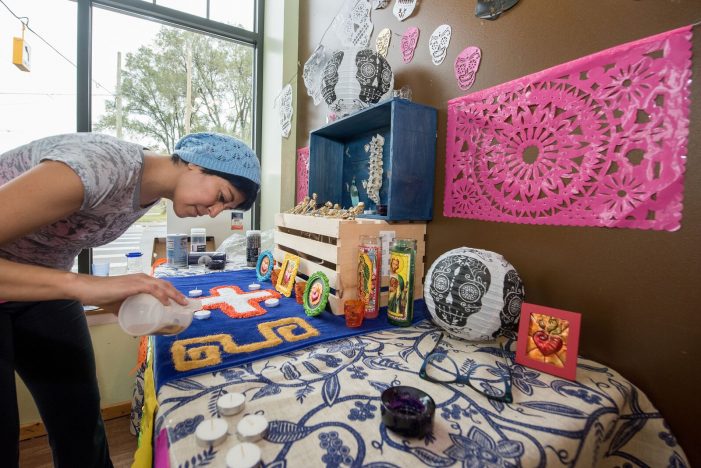
Photo: Paul Engstrom
Day of the Dead: Southwest Detroiters celebrate ancestors with ancient tradition
By E. B. Allen
It was an eye-opening experience for Grisel Alfaro.
Raised in a Puerto Rican family, she was familiar with the annual Día De Los Muertos– Day of the Dead – but her customs during the early November tradition were considerably understated.
“We Puerto Ricans celebrate, but it’ s more subdued,” she says. “We pray, we go to church, but it’ s not as festive as the way Mexicans do it.
“When I learned that you would gather at the cemetery and bring food, I said, ‘ What?’”
Years later, Alfaro is not only familiar with original traditions of the spirited holiday celebrated throughout much of North America, but she embraces them. A Spanish instructor at Milford High School, she leads about 70 students on ayearly autumn field trip to the center of the action, but it’ s not a flight to Mexico. A bus travels about 40 minutes to Southwest Detroit where Alfaro and her students take in visuals and experience camaraderie in churches, bakeries and on active streets where the living pay tribute to departed ancestors.
Detroit’ s celebration of the ancient Mexican tradition is the state’ s largest and the region’ s most popular.
“It’ s the closest to the real thing,” says Alfaro, who started bringing her students in 2010.

sugar skulls and other edible treats.

are created to bring attention, prayers and support concerning
issues that impact the community, such as gun violence.
Coinciding with the Catholic celebrations of All Souls and All Saints Days, Día de los Muertosis a Mexican celebration that honors the deceased November 1 and 2. Not to be confused with Halloween or any of its symbols, the observance incorporates creating ofrendas or altars, displaying flor de cempasúchil or marigolds, visiting graves and leaving gifts, and other gestures that inspire happiness over grief. Recognized in Mexico, some Central American countries, and American cities with substantial Hispanic populations, the United Nations Educational, Scientific and Cultural Organization has declared Día de los Muertos an Intangible Cultural Heritage.
The holiday attracts about 5,000 people to Southwest Detroit between late October and mid-November, according to the Southwest Detroit Business Association (SDBA).
“It has far exceeded our expectations,” says Kathy Wendler, SDBA president.
Through the former Mexicantown Community Development Corp., SDBA started promoting Día de los Muertos festivities in the late-1990s, hosting public visits to cultural, business and religious landmarks like the Holy Redeemer and St. Anne Catholic Churches.
“The reason we don’ t do tours anymore is when we did organized tours for years the students, the teachers and the visitors became so comfortable in the neighborhood they decided they didn’ t need us as tour guides anymore,” says Wendler.
Business activity and patronage of the area increases by about 75 percent during Día de los Muertos festivities, says Myrna Segura, SBDA director of business district development.
“In the past it was used as a tool to attract more visitors,” Segura adds. “Now, it’ s probably even more popular in Southwest Detroit than Cinco De Mayo.” Held during spring, the Cinco de Mayo parade is another high-profile Hispanic event commemorating the Mexican army’ s victory over France in 1862.
This year’ s events also include the five-kilometer or 10-kilometer “Run of the Dead” on Nov. 7. Routes will take participants past two Southwest Detroit cemeteries, and runners will be greeted with live musical entertainment and receive free t-shirts depicting La Catrina, the image of an elegant woman’ s skeleton. Race information is available at https://www.active.com/detroit-mi/running/run-of-the-dead-5k-10k-2015.
Skeletons are common in Southwest Detroit during the holiday as are “sugar skulls”and other edible treats like “Day of the Dead Bread.” In addition to remembering loved ones, ofrendas are created to bring attention, prayers and support concerning issues that impact the community, such as gun violence.
Brightly colored skull face painting is also popular. While that tradition might alarm some churchgoers who celebrate, Donald Hanchon, auxiliary bishop of the Archdiocese of Detroit, who oversees 55 Catholic parishes, says early Christians “sort of baptized the tradition.”
“They observed the customs and they saw many of the indigenous peoples, especially the Aztecs, have a great devotion to their ancestors, as many cultures do,” says Hanchon, who observed Día de los Muertos in the 1980s while studying in Mexico. “They had to believe their ancestors existed in some form, so they would bring to the graveyard some food or drink that their ancestor liked.”
Since Christians shared belief in an afterlife, Hanchon says “All Saints Day” is observed Nov. 1 as a religious “day of obligation,” usually spent in church, at the same time as Día de los Muertos, followed by “All Souls Day” Nov. 2. As a former parish priest, Hanchon welcomed altar tributes by Día de los Muertos observers. “Once I even had a statuette that fit in your hand that someone gave me, and there was a priest in the confessional and another person on the other side giving confession, and both of them were skeletons,” he chuckles.
While celebrated a day after Halloween, Día de los Muertos is not about ghosts, witches or fear, but about love and reflection.
“It’ s a very happy event that looks at death as more of a transition, not so much as a loss, and through which we can connect with people who we loved and who have had a positive influence on our lives,” says the SDBA’ s Wendler.


